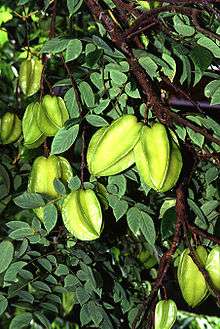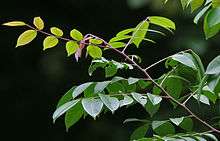Averrhoa carambola
| Averrhoa carambola | |
|---|---|
 | |
| Carambolas still on the tree | |
| Scientific classification | |
| Kingdom: | Plantae |
| (unranked): | Angiosperms |
| (unranked): | Eudicots |
| (unranked): | Rosids |
| Order: | Oxalidales |
| Family: | Oxalidaceae |
| Genus: | Averrhoa |
| Species: | A. carambola |
| Binomial name | |
| Averrhoa carambola L. | |
Averrhoa carambola is a species of woody plant in the family Oxalidaceae; it has a number of common names, including carambola and starfruit.[1]
This evergreen tree is native to Southeast Asia and the Indian Subcontinent.[2][3] A. carambola is a small tree or shrub that grows 5–12 metres tall, with rose to red-purple flowers. The flowers are small and bell-shaped, with five petals that have whitish edges. The flowers are often produced year round under tropical conditions.
The tree is cultivated in tropical and semitropical regions for its edible fruits and for its medicinal uses.
Description


Averrhoa carambola is a small, slow-growing evergreen tree with a short-trunk or a shrub. The branches are drooping and the wood is white and turns reddish.[4] It has a bushy shape with many branches producing a broad, rounded crown. The compound leaves are soft, medium-green, they are spirally arranged around the branches in an alternate fashion. The pinnate leaves have a single terminal leaflet and 5 to 11 nearly opposite leaflets, each leaf is 15–20 cm long, and the 3.8–9 cm long leaflets are ovate or ovate-oblong in shape. The top sides of the leaves are smooth and the undersides are finely hairy and whitish. The leaflets are reactive to light and tend to fold together at night, they are also sensitive to abrupt shock and when shaken tend to close up also. The lilac or purple-streaked, downy, flowers are produced in the axils of leaves at the end of twigs. The flowers are arranged in small clusters on the ends of the branches or sometimes on the larger stems and trunk, each cluster is attached to the tree with red stalks. The bell shaped, perfect flowers, are produced in loose panicles that are much-branched with pedicellate flowers; each flower is around 6 mm wide, with 5 petals that have recurved ends. The fruits are showy with an oblong shape: they are longitudinally 5- to 6-angled and 6.35–15 cm long and up to 9 cm wide. The fruits have a thin, waxy skin that is orange-yellow colored. The juicy fruits are yellow inside when ripe and have a crisp texture and when cut in cross-section are star shaped. The fruits have an oxalic acid odor, which varies between plants from strong to mild, the taste also varies from very sour to mildly sweetish. Each fruit may have up to twelve 6-12.5 mm long seeds, which are flat, thin and brown. Some cultivated forms produce fruits with no seeds.[5][6]
Taxonomy


The species in the genus Averrhoa along with the species in genus Sarcotheca are the only woody, tree-like plants belonging to the Oxalis family Oxalidaceae. The Oxalis family has nearly 900 species, most are herbaceous perennials or annuals native from tropical and semitropical locations though a number also grow in other parts of the world. Averrhoa has sometimes been placed in the family Averrhoaceae.[7] Averrhoa carambola is one of two species in the genus Averrhoa, both have edible fruit; the other species Averrhoa bilimbi, which is sometimes called the Bilimbi or the Cucumber Tree, is limited to tropical regions. The fruits of A. bilimbi are too sour to be eaten raw, while the sweet forms A. carambola are eaten raw. The fruits of A. bilimbi and the sour forms, which have high oxalic acid content, of A. carambola are pickled and made into jelly, jam, and juice. The genus was named after Abū 'l-Walīd Muḥammad bin Aḥmad bin Rushd (better known just as Ibn Rushd), who was called Averroes in European literature - a famous Arabian physician,[8] astronomer and philosopher of the 12th century.[9]
Past synonyms include:[10]
- Averrhoa pentandra Blanco, Fl. Filip., 392. 1837.
- Averrhoa acutangula Stokes, Bot. Mat. Med. vol. 2, 543. 1812.
- Connaropsis philippica Villar in Blanco, Fl. Filip. ed. vol. 3, app. 33. 1880.
The tree and fruits have many different names, Carambola is the Spanish vernacular name of the tree.[8] In English it is called Star fruit, Carambola and Chinese gooseberry,[11] in Malaysia and the Philippines it has numerous names.[9] In Indonesia it is called belimbing, in Tagalog it is called balimbing. The related bilimbi is called kamias in Tagalog.
Cultivation

Averrhoa carambola has a number of different forms differing in fruit taste, texture, and shape, some are very acidic and others are sweet. The plant is grown in Malaysia and Taiwan, with smaller concentrations in Thailand, Israel, Florida, Brazil, Philippines, China, Australia, Indonesia and the warmer parts of India and other areas of the world with the same climate. It has become a commercial crop in many of these locations, grown for its edible fruits.[12] The flowers need cross pollination to produce fruit, thus seed raised plants are variable. Plants may flower and bear fruit in about a year after seed germination. Larger plants may bloom year round in tropical areas as long as environmental conditions are suitable, plants may have flowers, unripe and ripe fruit at the same time. Under other climate and environmental conditions, plants tend to bloom in spring, and then off and on again during the rest of the year. Many different cultivars are grown, most are selected to optimize fruit flavor and maximum fruit production for specific growing areas, with each country or region having their own specific selections.[12]
Toxicology
Like several other plants of the family Oxalidaceae, its fruits are rich in oxalic acid, which is toxic in high concentrations.
There have been reports of intoxication in dialysis and uremic patients caused by a neurotoxin called caramboxin[13] present in the fruit. Such toxin is normally filtered by the kidneys, but patients in dialysis or suffering from kidney deficiencies may show severe symptoms, in a few cases fatal,[14] after drinking the fruit juice.
References
- ↑ http://www.itis.gov/servlet/SingleRpt/SingleRpt?search_topic=all&search_value=Averrhoa+carambola&search_kingdom=every&search_span=exactly_for&categories=All&source=html&search_credRating=All
- ↑ Carambola
- ↑ Avverhoa Carambola L.
- ↑ Author, L.D. Kapoor (1990), CRC handbook of ayurvedic medicinal plants, Boca Raton, Fla.: CRC Press, p. 58, ISBN 0-8493-0559-4
- ↑ http://www.ntbg.org/plants/plant_details.php?plantid=1377
- ↑ Editors, P.K. Warrier; Illustrations, R. Vasudevan Nair (2002), Indian medicinal plants : a compendium of 500 species, Madras: Orient Longman, p. 224, ISBN 81-250-0301-0
- ↑ http://www.ars-grin.gov/cgi-bin/npgs/html/genus.pl?1191
- 1 2 Deborah, Pauline; Waller, Ridling (4 February 2006), "Glow with stars:", Hindu: Online edition of India's National Newspaper, Chennai, India
- 1 2 Quattrocchi, Umberto (2000), CRC world dictionary of plant names : common names, scientific names, eponyms, synonyms, and etymology, Boca Raton: CRC Press, p. 241, ISBN 0-8493-2673-7
- ↑ "Averrhoa carambola L" ipk-gatersleben.de.
- ↑ House of Commons of the Parliament of Great Britain (1884). Parliamentary Papers, House of Commons and Command, Volume 54. p. 203. Retrieved 30 May 2013.
- 1 2 Ray, P.K. (2002), Breeding tropical and subtropical fruits, New Delhi: Narosa Pub. Pub. House, pp. 307–09, ISBN 3-540-42855-0
- ↑ Carolino, R.O.G (2002), Atividade Biológica e Purificação Parcial da Neuritoxina da Fruta Averrhoa carambola L. (Oxalidaceae)., Ribeirão Preto, SP, Brazil: Departamento de Bioquímica da Faculdade de Medicina de Ribeirão Preto - USP
- ↑ CHANG, J.M., HWANG, S.J., KUO, H.T. et al. Fatal outcome after ingestion of star fruit (Averrhoa carambola) in uremic patients. Am J. Kidney Dis 35:189-193, 2000.